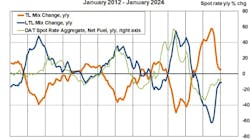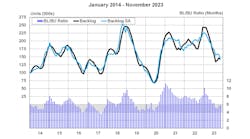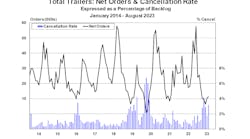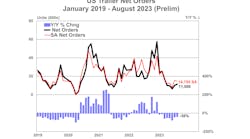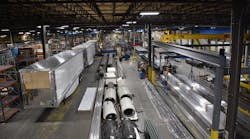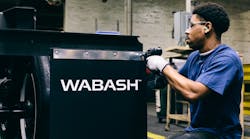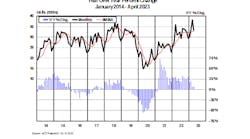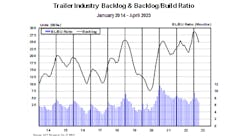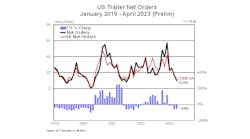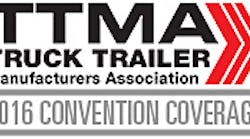Bob Costello, senior vice president and chief economist for the American Trucking Associations (ATA), said if he were addressing a truck audience, his message would be different. And more negative.
But the news, while not electrifying, is better for trailer manufacturers.
While tractor counts remain well below all-time highs, some sectors are adding trailers to boost trailer-to-tractor ratios. He said capacity is expected to tighten going into 2017 as volumes improve and the electronic logging device (ELD) mandate gets closer.
“We have seen evidence that fleets are increasing their trailer-to-tractor ratio,” he said. “At the end of the day, drivers’ time is going to be so important. Now we’re starting to see medium and small fleets say, ‘I have to get my drivers in and out of the customers’ facilities faster. I especially want to go to electronic logging devices.’
“There are some challenges in the ability and willingness to add capacity, but it is a little bit better for those of you in the trailer market than those in the truck market.”
In terms of trailer count changes, year-to-date and year-over-year: TL is up 1.5%; LTL doubles are down 0.2%; and LTL singles are up 4.1%.
By trailer type, year-to-date and year-over-year: dry van, up 2%; flatbed, up 5%; reefer, up 11%; and tank truck, up 1%.
“Refrigerated freight has puzzled me,” Costello said. “That sector is the most volatile on a month-to-month basis. You have seasonal things, ice cream in the summer months, holidays in the fall, the growing season. But we are learning in this sector that fleets are starting to transport more products in an ambient environment than they used to. Just at mean temperature. I’ve got members starting to haul a lot of cosmetics. I suspect that if you looked at some of this freight, it’s leaving the traditional dry van arena and gone over into temperature control. Even if it’s not cold or frozen, it’s just being held at room temperature.”
The Class 8 tractor sales picture is rather bleak. Including company tractors and independent contractors, TL was down 0.4% and LTL up 2.1% in January year-over-year. But TL fleets will count for 95% of all numbers, while LTL is just 5%.
“From talking to my fleets, there’s the ability to buy and the willingness to buy,” Costello said. “They are two very different things.”
Ability to buy:
• Freight rates have slowed and are even contracting in some sectors. “It’s a tough season right now. I don’t quite get it because shippers are saving a ton of money on fuel and yet are still pushing for their actual freight rates to come down. I think that’s a short-sighted strategy. When you get to ELDs being implemented, hours of service rules, things are likely to tighten up again. I think shippers should be careful.”
• Used truck prices have softened.
Willingness to buy:
• Freight volumes have slowed.
• The driver shortage, while still a problem, is not as bad because some oil-field drivers have come to the OTR market.
• Average miles per truck per month remain lower. “This is for a whole host of reasons, the biggest being that the supply chain has changed. In the retail supply chain, if you go back 15 years ago, the average haul was 750-800 miles. Today, those same fleets are averaging 400. Why? Because big-box retailers, to compete with Amazon, have built a lot more DCs so they can get the freight where it needs to be much faster.”
• New trucks get significantly better fuel economy than trucks built five years ago.
From an overall economic standpoint, Costello said there are two good signs:
• Consumer spending drives a significant amount of dry van, dedicated, and temperature-controlled truckload freight.
• Housing starts are important for some flatbed fleets and dry van.
The four bad signs:
• Factory output is quite soft, which impacts LTL fleets and many TL sectors (dry van, tank truck, flatbed).
• Energy production (frack well drilling) has hurt many tank truck and flatbed carriers.
• The current inventory cycle is a big drag on freight volumes.
• Energy production. “What we’ve learned from the downturn in energy: It’s not so much the impact on trucking. It’s not so much how we’re producing. It’s whether or not we’re drilling more wells. That’s where the bulk of the new freight demand came from. Production is not that far off, but we are getting rid of wells and not adding new ones. So that freight has just dried up.”
Real GDP is forecast to be 2.7% in Q3 and 2.8% in Q4 for yearly growth of 2.1%. The forecast for 2017 is for 2.8% growth.
Costello described job growth as “solid”: a forecast of 248,000 in Q3 and 220,000 in Q4. That’s well off the peak of 335,000 in November 2014 but still healthy.
Real personal disposable income growth, after being at 3.4% in 2015, is projected to be 2.9% this year.
He said total retail sales have been flat since The Great Recession, but e-commerce sales have been on a steady incline and are up 1433% since 2000.
“This is important because when excluding autos, gasoline, and food and beverage, on-line sales are 15% of total sales,” he said.
Restaurant sales have been up 43% since 2010, and grocery store sales are up 18%.
The ISM index has predicted all 10 recessions since 1950, plus 14 more recessions that never happened.
“It over-predicts,” Costello said. “Truck freight is the exact same way. Truck freight over-predicts recessions. So don’t panic. The good news is, we’re back over the growth line of 50.”
He said consumers are the biggest part of the economy and the biggest part of truck freight.
“It feels worse to fleets out there than it should,” he said. “Let’s go back to 2014. That was a great year for the trucking industry in terms of truck freight. Shippers couldn’t get stuff moved. The spot market rates went up 125%, contract rates were going up mid to high single digits.
“I’ve talked to lot of shippers. Near the end of 2014, I heard the same message over and over: ‘We can’t let this happen again.’ My question was, ‘Well, what are you going to do about it?’ What I heard over and over: ‘We’ve got to hold more stock, so when we need something moved, we are not at the mercy of going out there and my carrier fleets have no capacity for me today.’ They paid much higher spot market rates. You even saw a lot of traditional truckload freight move into LTL space simply because there wasn’t enough truckload capacity. They decided, ‘We need to hold more inventory.’
“In late 2015, shippers made a concerted effort to hold more inventory on hand so they are not caught by this. At the same time, we had a really weak first quarter in terms of GDP growth, and you had the West Coast port situation. Next thing you know, they overshot it.
“So what I tell fleets is, the good news here is we don’t need to get back down to those lowest levels you’ve seen. In fact, shippers don’t want to get there because that means there are too lean inventories. At this juncture, we want to see this line start to go south. When we see that, the fleets start to feel better. Maybe at the end of the day, we end up halfway down to the lowest points.”
Costello said crude oil production is down 5% since 2015, and the oil rig count is down 72%.
“For the trucking industry, it’s not how much we’re pumping—it’s how many new wells we’re drilling,” he said. “That’s where freight is, and that has gone away. Will it come back? Sure. Once we see oil at a much higher level, I think you’ll see some more wells.”
Costello said he is not forecasting “the greatest year ever” for the overall economy, but he remains confident that there will not be a recession in the next 12 months.
“Sure, the probability has gone up a little bit,” he said, “but I think there are still a lot of good things in the economy to avoid a recession. Let’s say 12 months down the line we do enter a recession. It would be very mild. Why would it be very mild? Nothing’s really out of whack.”
Costello’s general trucking themes:
• Truck freight volumes weakened considerably through 2015. Growth this year will remain uneven by sector and weak during first half of the year.
• Revenue per mile grew in 2015 for contract freight, but weakened throughout the year. The spot market is very soft.
• The driver shortage remains tough, but a combination of pay hikes and oil-field weakness helped in the short-term.
• Fleets continue to see rising costs. Fleets are using fuel savings to pay drivers more, replace trucks, and add trailers.
In terms of the operational per-mile costs of trucking, after aggressively increasing pay over the last two years, many TL fleets are still compelled to raise driver pay in 2016. Driver wages and benefits account for 35% of their costs, followed by fuel (34%, excluding fuel surcharges), equipment (22%) and everything else (9%).
“Most truckload carriers are going to recoup 60% to 70% of their fuel spec from their customer,” he said. “Now some of the fleets have gotten into a little bit of trouble. Some of the smaller fleets have a baseline of the fuel surcharge and it keeps them over that. Well, when we were at $4 a gallon, some shippers were telling some of the smaller fleets, ‘We need to raise that baseline.’ And some of them did. And now we’re back below that. So those carriers are really hoping for higher fuel prices.”
The average price of diesel was $3.83 in 2014, $2.71 in 2015, and is projected to be $2.12 in 2016 and $2.32 in 2017.
Costello said there is 90% driver turnover in the TL space.
“If you can keep a driver for 90 days, those rates drop in half,” he said. “Sometimes we’re our own worst enemies. We put in signup bonuses. I suspect that really does increase driver turnover rates. LTL has 10% turnover.
“The driver shortage was 48,000 in 2015. At current trends, it would balloon to 175,000 in 2024. I’ll tell you right now: I don’t believe that will happen. We would be in for a world of hurt if it does. I don’t care what the product is. If you are short, the price goes up. So the driver pay goes up. Even this year, when freight has been a little soft, there are a lot of fleets that have been increasing driver pay. From 2015 to 2024, we need to attract 900,000 new drivers to this industry. The #1 reason: retirements.” ♦
